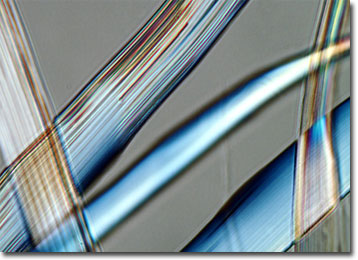Differential Interference Contrast Image Gallery
Wild Silk Fibers
Silk production was originated by the Chinese, who kept it as a closely guarded secret, approximately 5,000 years ago. Believed by some in medieval times to protect the wearer from disease, silk continues to hold a certain prestige as a luxury fiber, although it is no longer revered as a supernatural substance.

An animal fiber, most commercial silk is produced by the caterpillars of several moth species belonging to the genus Bombyx and are commonly referred to as silkworms. Virtual eating machines, cultivated silk worms can increase their body size up to 10,000 times their original dimensions in less than a month. When they are ready, they begin cocooning and extrude a semi-liquid mixture of protein and a sticky substance known as sericin. Hardening upon exposure to air, this liquid silk becomes the fiber that enshrouds them from the outside world while in their cocoon.
Each silkworm cocoon yields a strand of silk about 1,000 yards long. If a moth attempts to emerge from its cocoon, however, the long strand is broken. Thus, most commercial operations treat the cocoons with heat or steam in order to avoid the occurrence. However, some entrepreneurs have found a demand for what is known as wild silk, which does not involve the premature demise of the insects that produce it. Instead, the silkworms live freely, eating whatever they desire, and are allowed to carry out their full metamorphosis. The result is a material that is generally coarser than cultivated silk because it is made from numerous broken strands, rather than a seamless single one, and is also variously colored due to the uncontrolled diet of the insects.
